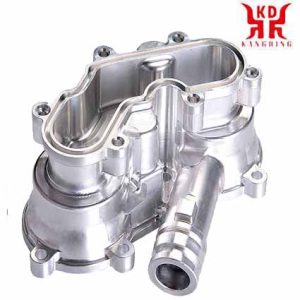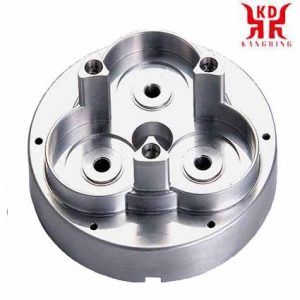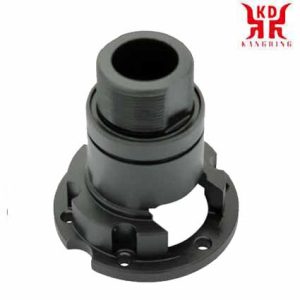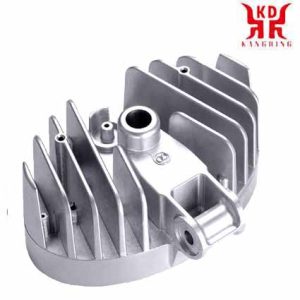In this article we will discuss the machining processes (turning, milling, finishing), tools, parameters and challenges involved in CNC machining aluminum and aluminum alloys. We also analyze the properties of aluminum and the alloys most commonly used in CNC machining, as well as their areas of application in various industrial sectors.

Rapid prototyping of aluminum alloy parts
If you are interested in CNC machining aluminum, you can request a quote for your parts here.
Aluminum is one of the most widely used materials today. In fact, aluminum is only surpassed by steel in terms of frequency of use in CNC machining. This is mainly due to the excellent machinability of aluminum.
In its pure form, the chemical element aluminum is soft, malleable, non-magnetic and has a silvery-white appearance. However, the element aluminum is not only used in its pure form. Aluminum is normally used in conjunction with various elements such as manganese, copper and magnesium to produce hundreds of aluminum alloys with various, significantly improved properties. The most common aluminum alloys and their respective designations in the various standards can be found here.
Figure 1: Pure aluminum
Benefits of using aluminum for CNC machined components
Although there are many different aluminum alloys with different properties, all aluminum alloys have the same essential properties.
Machinability
Aluminum can be shaped and machined using a variety of different methods. It can be cut quickly and easily with the help of processing machines because it is soft and has high machinability. It is also cheaper than steel and requires less machining. These properties are of great benefit to the cutting machine operator and the customer. In addition, aluminum is less deformed during machining due to its high machinability. This leads to higher accuracy, as CNC machines can achieve higher tolerances.
Strength to weight ratio
The density of aluminum is about a third of the density of steel. So aluminum is relatively light. Despite its low weight, aluminum is very strong. This combination of high strength and low weight is described by the strength-to-weight ratio. Its high strength-to-weight ratio makes aluminum an advantageous material for components in various industrial sectors, such as the automotive and aerospace industries.
Corrosion resistance
Aluminum is scratch and corrosion resistant under typical marine and atmospheric conditions. These properties can be enhanced by anodizing. It should be noted, however, that corrosion resistance varies with the type of aluminum. However, the most common types of aluminum used in CNC machining have the highest resistance.
Behavior at low temperatures
Most materials tend to lose some of their beneficial properties at temperatures below zero. For example, both carbon steel and rubber become brittle at low temperatures. In contrast, aluminum remains soft, malleable and strong even at very low temperatures.
Electric conductivity
The electrical conductivity of pure aluminum at room temperature is 36.7 million Siemens per meter. Although aluminum alloys can have lower conductivities than pure aluminum, they are conductive enough to be used as electrical components. On the other hand, aluminum is unsuitable if a high electrical conductivity of the manufactured component is undesirable.
Recyclability
Since CNC machining is a subtractive manufacturing process, a lot of chips and therefore a lot of material waste occur during machining. Aluminum is well suited for recycling, i.e. relatively little energy, effort and costs are required to recycle aluminum. This also makes it an advantageous material in terms of avoiding waste of material. This also makes aluminum a more environmentally friendly material in CNC machining.
Anodizing
The anodizing process is a surface finishing process that improves the wear resistance and corrosion resistance of a material. Aluminum is suitable for the anodizing process. This process also makes it easier to color the manufactured aluminum components.

CNC milling of aluminum parts
Popular aluminum alloys for CNC machining
In our experience, the following 5 types of aluminum are most commonly used in CNC machining.
EN AW 2007
Alternative names: 3.1645; EN 573-3; AlCu4PbMgMn.
This aluminum alloy contains copper as the main alloying element (4-5% copper). It is a short-chip alloy that is light, durable, highly functional and has the same mechanical properties as AW 2030. It is also suitable for thread cutting, heat treatment and high speed machining. All these properties make EN AW 2007 a widely used material in the manufacture of components, bolts, screws, nuts, rivets and threaded rods. However, this type of aluminum has poor weldability and corrosion resistance; It is therefore advisable to use protective anodizing after the component has been manufactured.
EN AW 5083
Alternative names: 3.3547; Alloy 5083; EN 573-3; UNS A95083; ASTM B209; AlMg4.5Mn0.7
AW 5083 is known for its excellent performance in harsh conditions. It contains magnesium and traces of chromium and manganese. This variety has a very high resistance to corrosion in chemical and marine environments. AW 5080 has the highest strength of all non-heat-treatable alloys; a property that it receives even after welding. While this alloy should not be used for applications with temperatures above 65 ° C, it has excellent performance in low temperature applications.
Because of its range of beneficial properties, AW 5080 is used for a wide variety of applications including cryogenic systems, marine applications, pressure systems, chemical applications, welded structures and vehicle bodies.

Surface finishing of aluminum alloy parts
EN AW 5754
Alternative names: 3.3535; Alloy 5754; EN 573-3; U21NS A95754; ASTM B 209; Al-Mg3.
As an aluminum-magnesium kneading material with the highest percentage of aluminum, AW 5754 can be rolled, forged and extruded. It is not heat treatable and can be cold worked to increase strength at the expense of formability. In addition, this alloy is excellent in corrosion resistance and has high strength. With these properties, it is not surprising that AW 5754 is one of the most widely used types of aluminum in CNC machining. It is commonly used in welded structures, floors, fishing gear, vehicle bodies, rivets, and in food processing.
EN AW 6061
Alternative names: 3.3206; ISO 6361; UNS A96060; ASTM B 221; AlMgSi0.5
This is a wrought alloy containing magnesium and silicon. It is heat treatable and has average strength, good weldability and good formability. In addition, it has a very high corrosion resistance; a property that can be improved by anodizing. EN AW 6060 is widely used in construction, food processing, medical technology and automotive technology.
EN AW 7075
Alternative names: 3.4365; UNS A96082; H30; Al-Zn6MgCu.
The main alloying element of this type of aluminum is zinc. Although EN AW 7075 has average machinability, poor cold forming properties and is unsuitable for welding or brazing, it has a high strength-to-weight ratio, excellent resistance to atmospheric and marine environments, and strength comparable to some steel alloys. This alloy is used in a very wide range of applications – from hang gliders, bicycle frames, climbing equipment and weapons to the construction of manufacturing tools.

Turned parts of aluminum alloy
CNC machining process for aluminum
Aluminum can be machined using many of the CNC processes available today. We have listed some of these procedures:
Turning
In CNC machining processes, the workpiece rotates while the single-point cutting tool remains stationary along its axis. Depending on the machine used, either the workpiece or the cutting tool performs a feed movement in order to remove the material.
Find out more about our CNC turning services.
Milling
Milling processes are the most frequently used methods when machining aluminum components. These methods consist of rotating a multipoint cutting tool along its axis while the workpiece remains stationary along its own axis. The cutting action and subsequent material removal is achieved by a feed movement of the workpiece or the cutting tool, or a combination of both. This movement can take place along several axes.
Find out more about our CNC milling services.
Pocket milling
Pocket milling, also known as pocketing, is a CNC milling method in which a hollow pocket is milled into a component.

CNC machining of aluminum alloy parts
Face turning and face milling
In machine processing, facing / milling is the creation of a flat cross-sectional area on the surface of a workpiece by turning / milling.
Drilling
Drilling is the process of creating a hole in a workpiece. In this process, a multi-point rotating cutting tool of a certain size moves in a straight line, perpendicular to the surface to be machined, effectively creating a hole.
Tools for aluminum processing
Many different factors play a role when selecting tools for CNC machining.
Tool design
Different geometry aspects of a tool contribute to the effectiveness in terms of aluminum machining. One of them is the number of cutting edges. In order to avoid difficulties in removing chips at high speeds, the cutting tools for aluminum CNC machining should have 2-3 cutting edges. A higher number of cutting edges leads to smaller chip bays. This causes the large chips of the aluminum alloys to get stuck. When cutting forces are low and chip evacuation is a major concern of the process, two cutting edges should be used. Three cutting edges can be used for the perfect balance between chip evacuation and tool strength.
Helix angle
The helix angle is the angle between the centerline of a tool and a straight tangent line along the cutting edge. While a high helix angle removes chips quickly, this also increases friction and heat generation during machining. This can cause chips to weld to the tool surface during high speed CNC machining of aluminum. A smaller helix angle results in less heat generation, but it may not be able to effectively remove the chips. When machining aluminum, a bevel angle of 35 ° or 40 ° is suitable for rough applications, while an angle of 45 ° is suitable for finishing work.
Clearance angle
The clearance angle is another important factor for the proper function of a tool. An excessively large angle would cause the tool to dig into the component and rattle back and forth. On the other hand, angles that are too small can lead to high friction between the tool and the workpiece. Clearance angles between 6 ° and 10 ° are particularly suitable for CNC machining of aluminum.

Aluminum die casting
Tool material
Tungsten carbide is the preferred material for cutting tools used in CNC aluminum machining. Since aluminum is very soft and easy to cut, the decisive factor in a cutting tool for aluminum is not the hardness, but the ability to obtain a razor-sharp edge. This ability is present in cemented carbide tools and depends on two factors, the cemented carbide grain size and the proportion of binder. While a larger grain size results in a harder material, a smaller grain size guarantees a tougher, more impact-resistant material that is exactly the property we need. Smaller grains require cobalt to achieve the fine grain structure and strength of the material.
However, cobalt reacts with aluminum at high temperatures and forms a built-up edge made of aluminum on the tool surface. The key is to use a cemented carbide tool with the right amount of cobalt (2-20%) to minimize this reaction while maintaining the required strength. Tungsten carbide tools are generally better suited to withstanding the high speeds of CNC aluminum machining than steel tools. In addition to the tool material, the coating of the tool is an important factor in the cutting efficiency of the tool.
ZrN (zirconium nitride), TiB2 (titanium boride) and diamond-like coatings are some of the suitable tool coatings for CNC machining of aluminum.
Feeds and speeds
The cutting speed is the speed at which the cutting tool rotates. Since aluminum can withstand very high cutting speeds, the cutting speed for aluminum alloys depends on the application limits of the machine used. As with CNC aluminum machining, the speed should be as high as possible, as this reduces the risk of built-up edges, saves time, minimizes the temperature rise in the component, improves chip breaking and improves the surface finish. The exact working speed depends on the aluminum alloy and the tool diameter.
The feed is the distance that the workpiece or tool is moved per revolution of the tool. The feed rate used depends on the desired surface finish, strength and rigidity of the workpiece. Rough cuts require a feed of 0.15 to 2.03 mm / rev, while finishing operations require a feed of 0.05 to 0.15 mm / rev.
Cooling lubricant
Despite its good machinability, aluminum should never be cut dry as this promotes the formation of built-up edges. Suitable cooling lubricants for aluminum CNC machining are soluble oil emulsions and mineral oils. Avoid cooling lubricants that contain chlorine or active sulfur, as these elements pickle aluminum. You can find out more about cooling lubricants here.

CNC machining aluminum alloy cavity
Post-processing processes
After machining an aluminum part, there are certain processes that can be carried out to improve the physical, mechanical and aesthetic properties of the part. The most common methods are listed below.
Pearl blasting – compressed air blasting with solid abrasive
Bead blasting is a finishing process for aesthetic purposes. In this process, the manufactured component is blasted with a strong jet of compressed air and tiny glass beads, which effectively removes the material and ensures a smooth surface. It gives aluminum a satin or matt surface. The most important process parameters for bead blasting are the size of the glass beads and the strength of the air pressure used. Use this procedure only when the dimensional tolerances of the part are not critical.
Other finishing processes are polishing and painting.
Coating
In this process, the aluminum workpiece is coated with another material, for example zinc, nickel or chromium. This is done to improve the functionality of the component and can be achieved through electrochemical processes.
Anodizing
The anodizing process is an electrochemical process in which the aluminum workpiece is placed in a solution of sulfuric acid. An electrical voltage is then applied between the anode and cathode. This process converts the exposed surfaces of the workpiece into an electrically non-reactive aluminum oxide coating. The density and thickness of the coating depends on the composition of the solution, the duration of the anodizing process and the electrical current applied. Anodizing can also be used to color the component.

Aluminum profile
Powder coating
In the powder coating process, the component is coated with a colored polymer powder using an electrostatic spray gun. The part is then cured at a temperature of 200 ° C. The powder coating improves strength and resistance to wear, corrosion and impact.
Heat treatment
Components made from heat-treatable aluminum alloys can be subjected to a heat treatment to improve their mechanical properties.
Applications of CNC-manufactured aluminum components in industry
As mentioned above, aluminum alloys have a number of advantageous properties. This is why CNC-manufactured aluminum components are indispensable in many branches of industry, including:
Aerospace: Due to the high strength-to-weight ratio, many aircraft fittings are made of aluminum.
Automotive industry: similar to the aerospace industry, many components such as axles and other components are made of aluminum.
Electronics: Due to their high electrical conductivity, CNC-manufactured aluminum components are often used as electrical components in electrical devices.
Food and pharmaceutical industry: Since aluminum does not react with most organic substances, aluminum components play an important role in the food and pharmaceutical industries.
Sports: Aluminum is widely used to make sports equipment such as baseball bats and whistles.
Low-temperature technology: Due to the ability of aluminum to maintain its mechanical properties even at temperatures below zero, aluminum components are often used in low-temperature applications.
 English
English العربية
العربية 中文(漢字)
中文(漢字) Čeština
Čeština Dansk
Dansk Nederlands
Nederlands Suomi
Suomi Français
Français Deutsch
Deutsch Italiano
Italiano 日本語
日本語 ಕನ್ನಡ
ಕನ್ನಡ 한국어
한국어 Português
Português Русский
Русский Slovenčina
Slovenčina Español
Español Svenska
Svenska Türkçe
Türkçe

